|
|
Reading assignment |
|
|
Movie shown |
|
|
Handout |
|
|
Online document |
|
|
Computer demonstration |
|
|
Student Presentation |
1. (We 97-08-27) Usual teaching staff (Prof. Brian Barsky and Dan Garcia)
| |
|---|---|
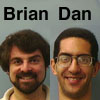
|
Introduction, student queries. We talked about enrollment issues, looked at the post-its from previous years and began a discussion of the reasons that made them work or not work.
|
2. (Fr 97-08-29) Usual teaching staff
|

|
We discussed camera motions and keyframing within the Post-It assignment context and the traditional animation process.
|
3. (We 97-09-03) Usual teaching staff
|

| We discussed the difference between camera dolly motion and zooming, what a scene and shot are in film contexts, depth-of-field, how to fake it using layers and blurring, compositing, and what people mean by saying things are "expensive". |
4. (Fr 97-09-05) Usual teaching staff
|

|
We looked at student post-it animations, discussed the next assignment.
UNIX and Emacs
|
5. (We 97-09-10) Usual teaching staff
|

|
Differences between computer animation and traditional animation
(what's easier to do in one domain and more difficult in the other).
We discuss what it means to be computer animation - if a computer
is used at any point in the process, is it computer animation?
|
6. (Fr 97-09-12) Usual teaching staff
|

|
We discuss the previous and next assignment, see a SPAM demo,
pass around an excellent storyboard by Denise Rees, and talk about
linear interpolation.
|
7. (We 97-09-17) Usual teaching staff
|

|
We choose what the morph order for next week's morph will be, see the Award-winning film "Hunger", and discuss it.
|
8. (Fr 97-09-19) Usual teaching staff
|

|
We see how to use the Morph program to do the next homework and see "Le paysagiste", a classic pinscreen movie.
|
9. (We 97-09-24) Usual teaching staff
|

|
We will have a crash-course in three dimensions,
see how to draw an articulated figures and understand hierarchies. We discuss how to do the next assignment.
|
10. (Fr 97-09-26) Ralph Guggenheim, Producer
|
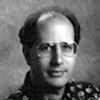
|
Ralph was the producer of Toy Story.
His talk will be an overview of the making of Toy Story,
discussing what it takes to make a feature animated
film. Not just the computer graphics, which in itself is an important part
of the process, but all the other elements that combined, make for an
enjoyable and entertaining experience.
|
11. (We 97-10-01) Usual teaching staff
|

|
We talk about and demonstrate the basics of a 3D software program: Modeling, Hierarchies, Textures, Lighting, Animation using the example program Infini-D on the Macintosh.
|
12. (Fr 97-10-03) Usual teaching staff
|

|
We learn how to animate our articulated figure using the sequencer, create a movie, flatten it using MoviePlayer and transfer it online using Fetch. Then we see how to edit our homepage to include the movie.
|
13. (We 97-10-08) Usual teaching staff
|

|
We learn how to grab clip-objects and textures from the Infini-D CDROM, discuss what Rube Goldberg animations are, which is the next assignment. We see "Luxo, Jr." and comment on the sophisticated animation techniques in this ground-breaking film.
HW due 10/15: Design a Rube Goldberg scene.
|
14. (Fr 97-10-10) Saty Raghavachary (Dreamworks)
|

| Saty is the technical lead (software development) for The Prince of Egypt at Dreamworks. This talk will present the use of custom 'Houdini' plugins for surface deformation. At DreamWorks Feature Animation we use these techniques in the 'Red Sea' sequence of our upcoming feature, 'The Prince of Egypt'. We will illustrate 5 or 6 plugins, discussing background principles, user interfaces and examples of each. |
15. (We 97-10-15) Usual teaching staff
|

|
Students present their Rube Goldberg designs and we discuss the way to share modeling tasks (by writing the name of the model, the machine and the student's name on the white board in 111 cory)
HW due 10/22: Model all your Rube Goldberg objects.
|
16. (Fr 97-10-17) John Berton, Jr. (ILM)
|

| John Berton is a Computer Graphics Supervisor at Industrial Light and Magic. He has been involved in computer graphics for film and video for more than 15 years, including seven years at ILM. He has been involved in such projects as "Terminator 2 - Judgment Day," "Casper," and "Star Wars - The Special Edition." He recently supervised much of the digital visual effects work on "Men in Black." John will speak about the integration of photo-realistic computer graphics with live action film, with examples from some recent ILM projects. |
17. (We 97-10-22) Usual teaching staff
|

|
We learn how to use Infini-D some more. We learn how to double-click on events and edit the details of an object, how to change the composition of a surface so that the back does not contain the same as a front (like in the earlier animations), how to edit a spline object and animate it over time, how to change lights and add more lights, why not to render in ray trace mode (but only use best and low anti-aliasing), how to change the display of the key-frame window, how to animate using splines (vs. linear key-frame interpolation), how to use the paths instead of just key frames, how to use the 'auto-banking' and reverse animation assistant, and we discussed the next assignment.
HW due 10/29: Animate your Rube Goldberg animation
|
18. (Fr 97-10-24) Eric Enderton (ILM)
|

| Eric Enderton, a UC Berkeley alumnus, has created computer graphics software for Industrial Light & Magic since 1990, for such films as "Terminator 2 - Judgement Day", "Jurassic Park", and the upcoming "Flubber". This talk describes the major stages in the computer graphics pipeline for 3D synthetic creatures, using examples from recent films, and surveying three categories of techniques: manual, procedural, and data capture. We discuss what makes useful software. |
19. (We 97-10-29) Usual teaching staff
|

|
Through consensus, we agree to push the due date of the final animations
for the Rube Goldberg piece forward a week. HW due 11/5: Choose which paper interests you from "Making them Move" and think of a final project story
|
20. (Fr 97-10-31) Laurence Arcadias (Kodak Imagination Works)
|
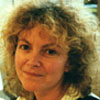
|
(see her Interactive Works)
She shows her work, starting from animations she directed when she was
in France to movies she did in the US. She explains how she started as a
traditional animator, how she got involved in computers and now, why she is
doing more interactive animation. She talks about different issues with
the new technologies and how it may influence her work in the future.
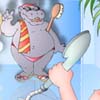 "TOILETTE-ZONE" - This is a short movie financed by A2 and C.N.C. (French National Center of Cinema.)
I directed it, I created the
characters and the story and animated some sequences mostly at the
beginning and I produced it with my company Amorce films. "TOILETTE-ZONE" - This is a short movie financed by A2 and C.N.C. (French National Center of Cinema.)
I directed it, I created the
characters and the story and animated some sequences mostly at the
beginning and I produced it with my company Amorce films.
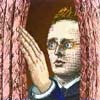 "THE DONOR PARTY" - This movie was done in Apple's Advanced
Technology Group (ATG) with
"Inkwell" and sponsored by "French Minister of Foreign Affairs". Only
one picture was created for each character per scene; outlines for the
characters were then animated and used to warp the characters for
animation. So far this movie has been shown in SIGGRAPH 93, MONTREAL:
IMAGES DU FUTUR, BERLIN INTERFILM FESTIVAL and ADELAIDE FESTIVAL in
AUSTRALIA. LOW RES FILM FESTIVAL. HOTWIRED. Released by VOYAGER with the
winners of the contest: "NEW VOICES NEW VISION" "THE DONOR PARTY" - This movie was done in Apple's Advanced
Technology Group (ATG) with
"Inkwell" and sponsored by "French Minister of Foreign Affairs". Only
one picture was created for each character per scene; outlines for the
characters were then animated and used to warp the characters for
animation. So far this movie has been shown in SIGGRAPH 93, MONTREAL:
IMAGES DU FUTUR, BERLIN INTERFILM FESTIVAL and ADELAIDE FESTIVAL in
AUSTRALIA. LOW RES FILM FESTIVAL. HOTWIRED. Released by VOYAGER with the
winners of the contest: "NEW VOICES NEW VISION"
 "TENNIS-RACKET" -
It is the movie I first did at Apple
with "Inkwell"
which is an experimental 2.5-dimension animation program built in
ATG Graphics
Group. "TENNIS-RACKET" -
It is the movie I first did at Apple
with "Inkwell"
which is an experimental 2.5-dimension animation program built in
ATG Graphics
Group.
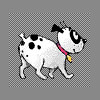 "SCREEN SAVERS" : "BAD DOG" -
This is my work when I was in Berkeley Systems.
I created and animated Chameleons and Bad Dog and worked with Dana Muise
on Mike's House "SCREEN SAVERS" : "BAD DOG" -
This is my work when I was in Berkeley Systems.
I created and animated Chameleons and Bad Dog and worked with Dana Muise
on Mike's House
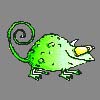 "SCREEN SAVERS" : "OFFENSIVE
CHAMELEONS" - First loop I did for "Totally Twisted Screen
Saver". It was judged too offensive by the management. Check on
"Chameleons After Dark" files for final version. "SCREEN SAVERS" : "OFFENSIVE
CHAMELEONS" - First loop I did for "Totally Twisted Screen
Saver". It was judged too offensive by the management. Check on
"Chameleons After Dark" files for final version.
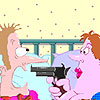 "INTERACTIVE ANIMATION" :
"I LOVE YOU": That was the fee to attend a Joe's Digital Dinner
Event for Valentine Day: $10 or a Digital Valentine. It's interactive,
just press any key on the Keyboard. "INTERACTIVE ANIMATION" :
"I LOVE YOU": That was the fee to attend a Joe's Digital Dinner
Event for Valentine Day: $10 or a Digital Valentine. It's interactive,
just press any key on the Keyboard.
|
21. (We 97-11-05) Usual teaching staff
|

|
22. (Fr 97-11-07) Dan Wexler (PDI)
|
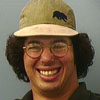
| Dan shows the making of Simpsons 3D, created by PDI. |
23. (We 97-11-12) Usual teaching staff
|

|
We see how to use Infini-D's modeler and illustrate how to both bend that object over time as well as morph one object into another.
|
24. (Fr 97-11-14) Ken Pearce (PDI)
|

|
Film production and software development make strange bedfellows.
The budgets, time pressures and work philosophies of feature film production are often incompatible with the conditions and concerns necessary for the development of reliable and efficient systems of software. Film production tends to inadvertantly encourage the rapid development of narrow, difficult-to-use, disposable solutions that often get re-written or re-invented with every project. So what happens when your mission is to support the immediate project-specific demands of a computer-generated feature film while simultaneously satisfying long-term corporate demands for a reliable, reusable, extensible software infrastructure? A snapshot of one evolving relationship between Hollywood and Silicon Valley. |
25. (We 97-11-19) Usual teaching staff
|

|
We see how to composite our sounds together using Avid Videoshop and create a
final sound movie. We learn how to paste this movie into a Quicktime movie
using Movieplayer. Finally, we learn about the three typical lighting elements
(key, fill and background) and how to implement these in Infini-D.
|
26. (Fr 97-11-21) Jonas de Miranda Gomes (IMPA in Rio de Janeiro)
|
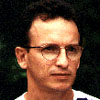
| This is a basic, introductory talk that discusses the fundamentals behind the operations of warping of arbitrary graphical objects. We will illustrate the concepts describing a generic warping technique which uses direct specification. |
27. (We 97-11-26) Usual teaching staff
|

|
We see how to use Infini-D 4.0, with its new interface and the sound channel.
|
28. (Fr 97-11-28) No class! Thanksgiving holiday. Gobble, gobble.
|
29. (We 97-12-03) Usual teaching staff
|

|
|
30. (Fr 97-12-05) Usual teaching staff
|

| We will summarize the course, suggest ideas for students who want to do more with animation, and see the final animations. |